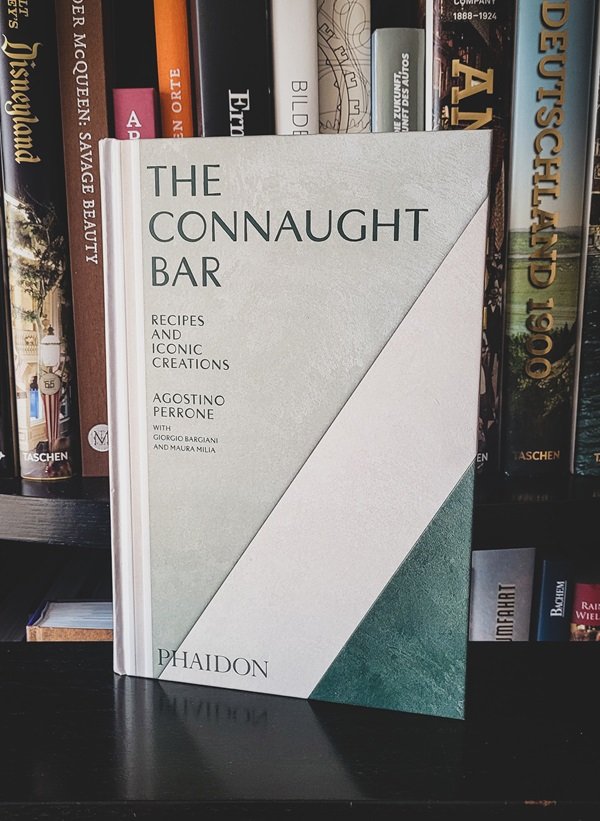The Connaught Bar - Agostino Perrone
The Connaught Bar
Agostino Perrone with Giorgio Bargiani and Maura Milia / 256 Pages / April 2024
This time we wanted to review a bar book as early as possible so that we can quickly help anyone interested in getting it. We are discussing one of the most anticipated bar books of recent years, namely the official and first work of the world-famous Connaught Bar in London.
Anyone with even the slightest interest in bar culture aside from mixing a bit at home will already be familiar with the location. Without going into too much detail, because hopefully we will also visit and review it this year: The Connaught Bar is considered one of the best bars in the world, and not just for the last 1–2 years. Voted the best bar in the world several times in the well-known World’s 50 list, it currently resides in 5th place.
In keeping with this reputation, the book naturally also has renowned foreword writers, such as one of the most decorated and best-known chefs in the world, Massimo Bottura. Since it's not particularly long, I don't want to spoil anything. However, his 3 pages are actually one of the most exciting and interesting forewords I have ever read in cocktail books, with his personal and modest touch.
Anistatia Miller, a well-known cocktail writer and “cocktail historian”, also contributed to the first pages — think of other greats such as Dale DeGroff, even if she is not quite as well known here in Germany. This is followed by two short pages on the basic philosophy of the Connaught Bar and host culture, as well as an introduction by the author himself, the typical personal background story. Before the real main part, we then only have “Tools of the Craft”, the obligatory part about the most important glasses, tools, and techniques (shaking, straining, etc.), really only in the most necessary length on 5 pages, without any pictures. The book is not aimed at those who still need to learn this, but somehow you can't leave it out either, I guess.
It really starts with Chapter 1 (of funnily enough only 2) and this is particularly interesting as it is only about one drink: the Connaught Martini, over 7–8 pages. One of the staples of the bar, it is made with a selection of selfmade bitters that can be chosen by the guest (the recipe for which is of course, or unfortunately, not disclosed). The special focus on just one signature drink as THE face of the bar is nice and something different, and also a reference back to some statements in Chef Bottura's foreword.
Now for the star of the book, the part that makes up 99% of the important content, Chapter 2 with 100 signature recipes from the Connaught Bar. Each recipe — and this is wonderful and very, very rare — gets a double page spread, photo on the right, exactly the same across all the pages. Each recipe also gets a text perfect in its length, sometimes with the story of how the idea came about, but for the most part also describing the structure of the drink and how each part contributes to the whole. This is exemplary in terms of lay out and execution and also helps to inspire and educate. You learn more than if you simply work through the recipes themselves but get a nice explanation.
As mentioned, there are only signature recipes, not a single drink is “this is our Manhattan” and a typical recipe follows, only with its own ratio and brands. At the same time, however, the rough basis on which the signature drink is based is often explained. This can be amusing when, for example, a classic drink with 3 ingredients is turned into a premix with 7 parts, 2 of which are exotic ingredients, 5 of which are infused or otherwise processed, and a culinary decoration is added.
Each drink is categorized in two ways, from 1 (low) to 3 (high) in terms of difficulty and ABV. You might think that there would be the fewest drinks in difficulty 3… Wrong. We are talking about the Connaught here. 38 drinks with Difficulty 3, and if you can do the math (100 in total), you'll notice that there are even more than 1/3. The levels for each drink are quite comprehensible and well-chosen. It should be noted here: For people who just want to buy something fresh from the supermarket and make a few drinks, the book is (unsurprisingly) less useful. There are indeed drinks for which you can start mixing with a visit to the supermarket and without time-consuming preparation of individual ingredients, but these are in the single-digit range. Some recipes themselves are not that difficult, but then suddenly there is a garnish for which you have to make a transparent disc of isomalt and roasted sesame seeds, and so on.
Following the cocktail recipes, we find the recipes for the homemade ingredients (everything is here, no preparation is explained in the drinks themselves), acknowledgements and a good index. I would like to emphasize one small aspect that I really liked: on one page, sous vide, a Thermomix and even an ultrasound machine are presented as preparation methods for the individual ingredients and how they should be used. But the author is also pleasantly open to other ways and explains how you can use a simpler method if you don't have the appliances. It's nice that such an upmarket institution is open to this and willing to “help” for the more normal bartender at home.
The entire piece is presented and finished to an extremely high standard. The book is the perfect size to let the photos shine, while being still practical to use. The surface is ingeniously textured and even the 3 diagonal layers on the cover are different heights, as if it were actually wrapped. The photos are all laid out very similarly, with only very subtle texture changes in the background, the drink always the clear focus, like a luxury catalog.
Conclusion:
The Connaught Bar's first book is a very well written work, precise and clearly structured. The latter is also due to the fact that there is actually little to structure, a bit more history about the hotel itself or the bar would have been nice. Nevertheless, the photos and the layout as a double page per drink + picture for each drink are a luxury decision, as is the appearance and design of the book.
To be clear: the book is absolutely not useful if you are the home bartender who likes to buy only from the local supermarket and rely on simple maceration and syrups and nothing more. But even they can be happy if they want to be inspired by the absolute best there is in the bar world. From a purely bar-cultural point of view, the book is worth its price already, but the high-quality exterior and the exciting 100 recipes at various levels of difficulty make it a no-brainer.




